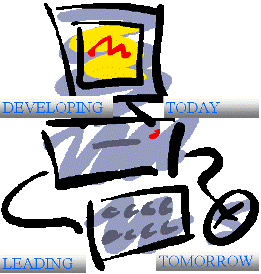XML the Basics 7
Summary
††††††††††† The W3C conveys the concept of XML by making 10 points:
- XML is for structuring data.
- XML looks a bit like HTML, since it uses tags (words bracketed by < and >).
- XML is text, but isnít meant to be read.† That means the XML code is available for your examination but you can just read the content contained between the code if you want.† As a user you can see it in a userís view (a screen of plain text information) and add or modify it to suit your needs.
- XML is verbose by design.† Since its format uses tags to delimit the data in a text type description, XML files are larger than comparable binary formats.
- XLM is a family of technologies.† This family is growing by offering more modules.† For example, Cascading Style Sheets (CSS) can be used.† CSS define the appearance of different elements such as headers and links.† It shapes the appearance of your document.
- XML is new, but not that new.† It is based on SGML and HTML as noted previously on page 3, paragraph 3.
- XML leads to XHTML.† This is the successor to HTML.† XHMTL is a document format developed by the W3C.† More information concerning the new technology can be found at W3Cís Web site.
- XML is modular.† Through XML schema and their convention, namespace, modules of other formats can be combined and reused.
- XML is the basis for Resource Description Framework (RDF) and the Semantic Web.† RDF is an XML text format that supports resource description and metadata applications that include music and photos.† It is semantic by providing a mechanism for reaching common definitions, an agreed meaning, which allows meaningful communications among computer users.
- XML is license free, platform independent and well supported.† You donít have to pay to use it.† You donít have to pay to build on it.† If you need help, there is a growing community of tools being made available for the technology.
XML the Basics 8
These 10 points serve as a summary of what XML is about and can start you to specific development of a project.† If you are a developer, it could be well worthwhile your consideration (Extensible Markup Language, 2003, www.w3.org/XML/1999/XML-in-10-points).
Conclusions
† ††††††††† In conclusion, XML is a powerful markup language that defines the meaning and structure of many types of documents.† Since it can be used with both structured and semi-structured data, it can be used with the most modern multimedia technologies for pictures and sound. It can be used with object oriented programming languages and give you the ability to move its code.†† Its Web capability has made it the de facto language for e-commerce.† Since it is free, platform independent and well supported, many organization have adopted it for use.† Even the government is considering its applications.† For example, the Food and Drug Administration (FDA) will require Standard Product Labeling, an XML based language, for prescriptions and over the counter drugs.
XML the Basics 9
††††††††††† Its drawbacks lie in the fact that it is so widely available and can be used in so many applications.† Because there are so many XML based languages to use, itís virtually impossible to be an expert in all of XML.† You could be an expert in applying it to e-commerce but know little in applying it to math or drug labeling.† Also, since its supports Unicode (computer representations for all the world languages), you may not recognize its content and consequently, not fully understand it.†† Finally, its open standard and open architecture exposes it to all the vulnerabilities of the Web.† If security is not adequate at a Web site, then the code could be exposed and exploited.
Return to Web Site's Index
DELAWARE'S MIDDLETOWN ODESSA AND TOWNSEND AREA
